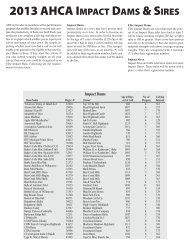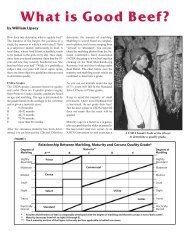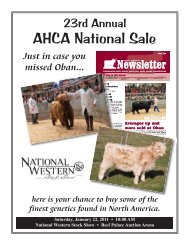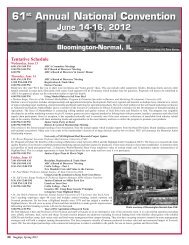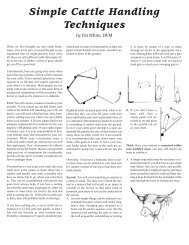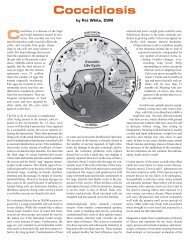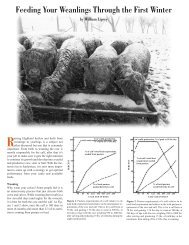The Bagpipe - American Highland Cattle Association
The Bagpipe - American Highland Cattle Association
The Bagpipe - American Highland Cattle Association
Create successful ePaper yourself
Turn your PDF publications into a flip-book with our unique Google optimized e-Paper software.
16<br />
NUTRITION<br />
GETTING STARTED GRAZING<br />
Ohio State University Extension<br />
<strong>The</strong> ruminant animals we work with on today’s farms have practiced grazing since before mankind discovered<br />
fire. Animals herded together for protection from predators and rotationally grazed to find new sources of<br />
forage. Rotational grazing on farms perhaps had its beginning with staking the animals out in a different<br />
location each day. Recorded history of the benefits of rotational grazing goes back at least to the 1700’s.<br />
Today we use the term Management-Intensive Grazing (MIG) to describe the art of grazing based on scientific<br />
principles. MIG is one of the most promising concepts in agriculture today! It promises to lower costs while increasing<br />
productivity and has proven to be<br />
one of the most environmentally<br />
friendly agricultural enterprises<br />
currently practiced.<br />
Well managed grazing operations<br />
can produce returns per acre<br />
equal to or greater than row crop<br />
income, without government<br />
subsidies. Your net return per acre<br />
will depend on your debt load,<br />
value of your land, intensity of<br />
management and value and<br />
pounds of product sold per acre.<br />
While a beef cow may produce 100<br />
pounds of calf per acre, and it<br />
takes 5 acres to keep one cow, this<br />
produces gross income of $60 per<br />
acre if calves are worth 60 cents<br />
per pound. If you are able to keep<br />
a cow on 1.5 acres, using a more<br />
intensive system, a 500 pound<br />
weaned calf will produce 333<br />
pounds of calf per acre and $200<br />
gross income. Additional fence<br />
and water development costs will<br />
have to be covered but it is<br />
apparent that becoming more<br />
intensive has the potential to<br />
increase net return due to lower<br />
fixed costs in land.<br />
Cow and calf benefitting from MIG.<br />
Environmental Benefits of Management-lntensive Grazing<br />
<strong>The</strong> environmental benefits of Management-Intensive Grazing (MIG) include reduced soil erosion, improved air<br />
and water quality, better plant diversity, vigor and production, and improved fish and wildlife habitat. Improving<br />
grazing management results in more complete vegetative cover and improved soil structure, that allows a higher<br />
percentage of the rainfall to infiltrate the soil where it can be used for plant growth rather than running off where it<br />
can result in soil erosion and sedimentation problems. Many ecological processes accelerate including decomposition<br />
of manure. Nutrients can then be recycled several times during the growing season. This improves overall soil quality.<br />
Water quality improves as the pasture vegetation becomes more dense and the soil condition improves. A<br />
University of Wisconsin study showed that pastures are the best “crop” for reducing runoff, erosion and phosphorous<br />
pollution over any other land use. A similar study done by USDA-Agricultural Research Service, North Appalachian<br />
Experimental Watershed at Coshocton, Ohio revealed that both surface and ground water quality in a pastured<br />
watershed was just as good or better than water leaving an adjacent pristine wooded watershed. Pasture soils are a<br />
terrific biological filter to recover nutrients passing through the soil. Grass roots are active nearly year-round and



